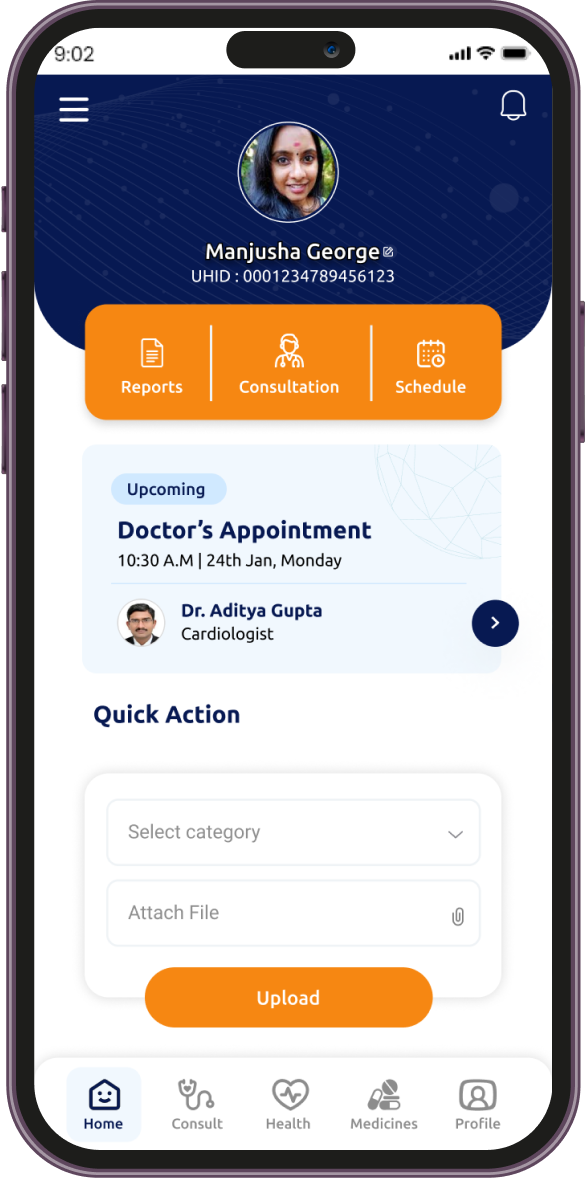
Home / Information / Blog / Blog Detail

Breast cancer is one of the most commonly occurring cancers in women around the world. However, men can also be diagnosed with it. This disease arises when abnormal cells in the breast begin to grow uncontrollably, resulting in the formation of a tumor. Recognizing the symptoms, understanding the causes, exploring treatment options, and adopting preventive measures are essential for early detection and improved outcomes.
What is Breast Cancer?
Breast cancer is a condition in which cells within the breast tissue proliferate and divide without regulation, resulting in a mass or lump referred to as a tumor. It can originate in different breast parts, including the ducts, lobules, and connective tissues. Some breast cancers grow slowly, while others spread aggressively to other parts of the body.
Types of Breast Cancer
Breast cancer is categorized into various types based on the specific areas affected and their spreading patterns. Some of the most common types include:
Ductal carcinoma in situ (DCIS): This type of cancer is noninvasive and characterized by abnormal cells in the breast duct lining that have not yet disseminated to nearby tissues.
Invasive Ductal Carcinoma (IDC): The most prevalent type of breast cancer, IDC, begins in the milk ducts and can invade nearby tissues.
Invasive Lobular Carcinoma (ILC): This type originates in the lobules, which are the milk-producing glands, and has the potential to spread.
Triple-negative Breast Cancer (TNBC): Known for its aggressive nature, TNBC lacks estrogen, progesterone, and HER2 receptors, making it challenging to treat.
HER2-Positive Breast Cancer: This form grows rapidly due to an overproduction of the HER2 protein, leading to a more aggressive disease.
Inflammatory Breast Cancer (IBC): A rare yet aggressive type, IBC obstructs lymphatic vessels, resulting in swelling and redness of the breast.
This summary highlights the different forms of breast cancer, stressing their unique characteristics and implications for treatment.
Symptoms of Breast Cancer
A new growth or swelling in the breast or armpit.
Swelling or thickening in part of the breast
Dimpling or irritation of breast skin
Nipple discharge that is not breast milk, which may include blood.
Changes in breast shape or size
Inverted nipples or nipple discomfort.
Redness, scaliness, or peeling of the skin on the breast or nipple

Causes and Risk Factors
The exact cause of breast cancer is not completely understood, but various factors can elevate the risk:
Genetic and Hereditary Factors: Changes in the BRCA1 and BRCA2 genes significantly increase the risk of breast cancer, especially for individuals with a family history of breast or ovarian cancer.
Hormonal and Lifestyle Factors:
Several factors can influence a woman's hormonal health throughout her life. Early menstruation (before age 12) and late menopause (after age 55) can play significant roles. Additionally, hormone replacement therapy (HRT) can be beneficial for managing menopause symptoms, while oral contraceptives offer various advantages for reproductive health. Moreover, experiences like late pregnancies or choosing not to have children can also impact hormonal balance and overall wellness.
Lifestyle and Environmental Factors:
Encouraging regular physical activity
Maintaining a healthy weight, especially during and after menopause
Moderating alcohol consumption
Quitting smoking for better health
Taking precautions against unnecessary exposure to radiation therapy
Diagnosis of Breast Cancer
Early detection is crucial for improving survival rates. The primary diagnostic methods include:
Breast Self-Examination (BSE): Regular self-exams to detect unusual changes.
Clinical Breast Exam (CBE): A physical exam by a healthcare provider.
Mammogram: X-ray screening to detect early-stage breast cancer.
Ultrasound and MRI: Imaging techniques to examine breast tissues.
Biopsy: A sample of breast tissue is collected to verify the presence of cancer.
Stages of Breast Cancer
Breast cancer is categorized into stages based on tumor size, lymph node involvement, and spread to other organs.
Stage 0: Non-invasive cancer (DCIS) confined to breast ducts.
Stage I: Small tumor with minimal lymph node involvement.
Stage II: Larger tumor and/or spread to nearby lymph nodes.
Stage III: Cancer spreads extensively to lymph nodes and nearby tissues.
Stage IV: Advanced stage where cancer has metastasized to other body parts like bones, liver, lungs, or brain.
Treatment Options for Breast Cancer
Treatment depends on the stage, type, and patient's overall health. Common treatment options include:
Surgery:
Lumpectomy: Removal of the tumor while preserving the breast.
Mastectomy: Partial or complete removal of one or both breasts.
Lymph Node Removal: Removing lymph nodes if cancer has spread.
Radiation Therapy:
Uses high-energy rays to kill cancer cells and shrink tumors.
It is often recommended after surgery to prevent recurrence.
Chemotherapy:
Uses drugs to destroy cancer cells.
Administered orally or intravenously, especially for advanced-stage cancer.
Hormonal Therapy:
Blocks hormones like estrogen and progesterone that fuel cancer growth.
Used for hormone receptor-positive cancers.
Targeted Therapy:
Focuses on specific cancer cell abnormalities.
HER2-positive breast cancer responds well to drugs like Herceptin.
Immunotherapy:
It boosts the body's immune system to fight cancer.
Effective for triple-negative breast cancer (TNBC).
Prevention of Breast Cancer
Although certain risk factors, such as genetics, cannot be altered, embracing a healthy lifestyle can help minimize the risk.
Maintain a Healthy Lifestyle:
Follow a balanced diet with plenty of fruits, vegetables, and lean proteins.
Exercise regularly to maintain a healthy weight.
Limit alcohol intake and avoid smoking.
Regular Screening and Self-Exams:
Women over 40 should get annual mammograms.
Conduct monthly breast self-exams to identify any changes.
Manage Hormonal Levels:
Avoid unnecessary hormone therapy.
Consider breastfeeding, which may lower the risk of breast cancer.
Know Your Family History:
If you have a strong family history, genetic testing for BRCA mutations can be beneficial.
Consider preventive measures like increased screenings or preventive mastectomy in high-risk cases.
Living with Breast Cancer
Receiving a breast cancer diagnosis can be overwhelming. Yet, support from family, friends, and healthcare professionals can significantly impact.
Join Support Groups: Connecting with others who have similar experiences can provide emotional support.
Adopt a Positive Mindset: Meditation, yoga, and therapy can help manage stress.
Follow a Healthy Diet: A nutrient-rich diet aids recovery and boosts immunity.
Stay Active: Engaging in light exercises can help improve physical and mental well-being.
Final Thoughts
Breast cancer awareness and early detection can significantly improve survival rates. Regular screenings, a healthy lifestyle, and being vigilant about symptoms are key to prevention. Various treatment options are available to ensure the best possible outcome if diagnosed. Remember, early detection saves lives!
Help Spread Awareness!
Share this blog with your family and friends to learn about breast cancer prevention and early detection.
With VivaVel, Stay informed and stay healthy!


Cancer is one of the most daunting health challenges of our time. Still, advancements in medicine and technology are transforming how it is diagnosed and treated. Understanding cancer and its various types is crucial for health tourists seeking specialized care to make informed decisions about treatment destinations. This blog explores cancer, its different types, and why health tourism can benefit patients.

Lung cancer is one of the most common and serious types of cancer worldwide. It occurs when abnormal cells in the lungs grow uncontrollably, forming tumors that interfere with normal lung function. Early detection is crucial for improving survival rates, yet lung cancer is often diagnosed in its later stages due to subtle initial symptoms. This article will explore lung cancer's causes, symptoms, risk factors, treatment options, and prevention methods.

Kidney cancer, also known as renal cancer, is one of the more common types of cancer that affects millions of people globally and remains undetected until it's too late. It's a type of cancer that develops in the kidneys. Kidneys are the two bean-shaped organs that filter waste and excess blood fluids. It is essential to be aware of its symptoms, risk factors, and treatment options to ensure early detection and effective management. This blog overviews kidney cancer, its causes, symptoms, and available treatment options.
STEP 1
Let us know your details and preferences. We maintain absolute data confidentiality. All your health records are safe, and privacy is maintained.
STEP 2
A dedicated counsellor will help you with the Best Hospital & Doctors at the lowest possible Prices.
STEP 3
While you decide on the treatment plan, we assist you with priority appointments, Visa, Documentation, Hotel & other Logistics.
STEP 4
Our team assists you with all your local requirements like Hospitalization, Hotel Stay, Transportation, Food, Forex, Lab Tests, Medicines, etc.
STEP 5
We ensure a smooth discharge process. We also assist you in tallying your bills at the hospital, all necessary documentation, and your return trip.
Happy Patient from Bangladesh | Gastroenteritis Treatment in Columbia Asia Hospital, India

"VivaVel" has truly made a life-changing impact on our lives during a challenging time. My wife was diagnosed with Polycystic Ovarian Disease (PCOD), and despite consulting three different doctors in Bangladesh, we were unsatisfied and uncertain about the way forward. It was a confusing and challenging phase until a friend recommended VivaVel.
From the moment "I contacted them", VivaVel provided exceptional support and guidance. They arranged telemedicine consultations with two renowned international doctors, giving us the confidence to make an informed decision. After careful consideration, we selected one of the doctors for my wife's treatment.
VivaVel's assistance went above and beyond our expectations. They helped us with critical processes like obtaining a medical visa invitation letter, visa processing, and coordinating my wife's admission to "Artemis Hospital" in Delhi. They even suggested comfortable accommodations for me as a patient attendant.
What truly stood out was their unwavering support throughout our journey. The "VivaVel team" was always just a phone call away, offering guidance and reassurance during our stay in Delhi. Their professionalism and dedication to helping patients and their families are truly commendable.
I am incredibly grateful for the care and support from "VivaVel." They were a beacon of hope for us during this difficult time, and I sincerely hope they continue their outstanding service to help more needy patients.
Thank you, "VivaVel," for being there for us every step of the way!
Mr. Hoque, Dhaka, Bangladesh
Patient name: Shanta Islam, Dhaka, Bangladesh.

Note : VivaVel does not provide medical advice, diagnosis or treatment. The services and information offered on www.vivavel.com are intended solely for informational purposes and cannot replace the professional consultation or treatment by a physician. All Copyrights are reserved with VivaVel. VivaVel does not allow copying and cloning of its webpages and contents. VivaVel reserves the right to follow the legal procedures to protect its intellectual property.
Copyright © 2025 VivaVel.com . All Rights Reserve.





